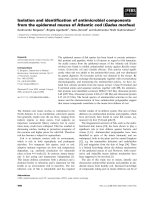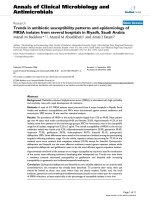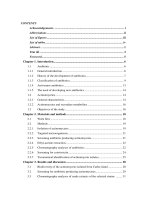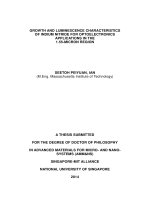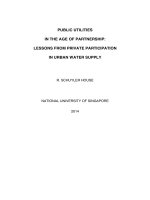Isolation and antibiotic susceptibility of campylobacter species from cattle offals in Gwagwalada abattoir, Abuja-FCT Nigeria
Bạn đang xem bản rút gọn của tài liệu. Xem và tải ngay bản đầy đủ của tài liệu tại đây (197.25 KB, 10 trang )
Int.J.Curr.Microbiol.App.Sci (2017) 6(4): 324-333
International Journal of Current Microbiology and Applied Sciences
ISSN: 2319-7706 Volume 6 Number 4 (2017) pp. 324-333
Journal homepage:
Original Research Article
/>
Isolation and Antibiotic Susceptibility of Campylobacter Species from Cattle
Offals in Gwagwalada Abattoir, Abuja-FCT Nigeria
H.O.K. Olabode*, S. Mailafia, M.E. Ogbole, G.R. Okoh, C.I.C. Ifeanyi,
H.O. Onigbanjo and I.B. Ugbaja
Department of Microbiology, Faculty of Veterinary Medicine, University of Abuja, Nigeria
*Corresponding author
ABSTRACT
Keywords
Isolation, Antibiotic
Susceptibility,
Campylobacter
species, Cattle
offals, Gwagwalada
abattoir
Article Info
Accepted:
02 March 2017
Available Online:
10 April 2017
This study was conducted to establish the occurrence and antibiotic susceptibility testing
on isolates of Campylobacter obtained in cattle offals slaughtered within Gwagwalada
abattoir. A total of 75 samples were collected over a period of five weeks using sterile
swab sticks for cultures on blood free selective Campylobacter agar (modified CCDAPreston) enriched with selective supplement and incubated at 42°C for 48 hours
microaerobically. The colonies were subjected to biochemical reactions of oxidase,
catalase, citrate, indole reaction, hydrogen sulphide production and motility test. Antibiotic
sensitivity test was also performed using an antibiotic impregnated multi-disk (Optudisc,
UK) Gentamycin (10µg), Streptomycin (30µg), Rifampicin (20µg), Erythromycin (30µg),
Ampiclox (20µg), Amoxicillin (20µg), Chloramphenicol (30µg), Levofloxacin (20µg) and
Norfloxacin (10µg). Cultural and Gram staining characteristics showed 68% were positive
for Campylobacter spp as gram negative curved rods. Biochemical reaction further
revealed isolates were motile, oxidase, catalase and citrate utilization positive, as well as
indole and hydrogen sulphide negative. Antibiotic sensitivity testing revealed that isolates
were sensitive to Gentamycin and Amoxil and resistant to Norfloxacin, Rifampicin,
Chloramphenicol, Streptomycin and Ampiclox but showed some effect to Ciprofloxacin,
Levofloxacin and Erythromycin. These Campylobacter isolates within offals has a
potential ability to contaminate meat obtained from the abattoir which may increase the
risk of human infection. This finding indicates the presence of Campylobacter isolates in
cattle offals showing resistance to commonly used antibiotics. Awareness campaign
amongst both butchers and the general public on the occurrence and possible
contamination of beef with Campylobacter is recommended with emphasis on safe and
wholesome meat preparation and good hygienic slaughtering practices.
Introduction
countries (Altekruse et al., 1999) and
characterized by Campylobacter gastroenteritis (Kapperud et al., 2003). The genus
Campylobacter comprises of about 16 species
and 4 sub - species (Vandamme, 2002) which
are Gram negative, micro-aerophilic, curved
or spiral rods, with a single polar flagellum
Campylobacteriosis is a significant emerging
bacterial foodborne zoonosis caused by the
bacterial genus of Campylobacter, primarily
associated with consumption of undercooked
poultry, other meat products (Mazick et al.,
2006) contaminated with faeces (Friedman et
al., 2000) especially in several industrialized
324
Int.J.Curr.Microbiol.App.Sci (2017) 6(4): 324-333
and a rather unique corkscrew motility (Quinn
et al., 1994).
Epidemiological studies have identified a
significant
association
between
Campylobacter infection in humans and
consumption as well as handling of poultry
(Wingstrand et al., 2006). However, other
studies reported similar association with cattle
(Garcia et al., 1985). This direct contact
exposure to bovine faeces and consumption of
unpasteurized cow milk are the leading causes
of acute bacterial Campylobacteriosis
outbreaks in cattle (Sato et al., 2004) and
humans globally (Nachamkin, 1995) with
enteric Campylobacteriosis been prevalent
amongst HIV-infected patients (Sorvillo et
al., 1991) and found to be resistant to
antimicrobial therapy especially C. jejuni
(Altekruse et al., 1999) alongside other
observed complications of Neuropathies such
as
Guillian-Barre
syndrome
(GBS)
(Godschalk et al., 2006), myocarditis
(Cunningham and Lee, 2003).
Campylobacter have been incriminated in a
variety of animal diseases including abortion
in sheep and goats (Andersen et al., 1983),
infertility and abortion in cattle, diarrhea in
sheep and cattle (Al-Mashat and Taylor,
1980), intestinal adenomitis in swine and
gastroenteritis and abortion in dogs (Adak et
al., 2005). Genital Campylobacteriosis in
animals have occurred during coitus and
artificial insemination (AI) in cows (Skirrow,
1977). However, Chicken and cattle are the
principal sources of C. jejuni pathogenic to
humans,
whereas
wild
animal
and
environmental sources have been associated
with about 3% of the disease (Wilson et al.,
2008).
The routes of transmission of Campylobacter
between food animals and humans are
numerous and complex (Andersen et al.,
2006). Foodborne transmission is the mode by
which majority of the cases occur. Raw
poultry meat has often been implicated as the
major source of human Campylobacteriosis
(Wingstrand et al., 2006).
The increasing concern based on previous
epidemiological studies on the potential role
of non-poultry sources for human clinical
infections
has
been
underestimated
(Ngulukun, 2009, 2011). The relative direct
and indirect contributions of cattle and sheep
to human infections are still poorly
understood (Frost, 2001). This premised the
study to investigate the occurrence and
antibiotic
susceptibility
testing
of
Campylobacter isolates in slaughtered cattle
offals from Gwagwalada abattoir for the
purpose of designing a disease control plan.
Contamination of cattle carcasses during
processing either directly or indirectly have
also been reported (Sharon et al., 2013).
However, person–to-person spread of
infection was reported but is uncommon
(Blaser et al.,1981) Human foodborne illness
have been reported post consumption of
Campylobacter contaminated bovine products
like unpasteurized milk (Sato et al., 2004) and
meat (Osano and Arimi, 1999) with serious
public health consequences (Besser et al.,
2005, Friedman et al., 2004). Contaminated
surface water run-off from bovine reservoirs
and cattle pastures and or direct cattle contact
(Friedman et al., 2000) were also documented
during disposal of abattoir effluents and
slurries which contaminates water for human
consumption (Tauxe, 1992).
Materials and Methods
Study area
Gwagwalada is one of the six Area Councils
of the Federal Capital Territory of Nigeria,
alongside Abaji, Kuje, Bwari, Kwali and
Abuja municipal area council. University of
Abuja is located in Gwagwalada, which has
an area of 1,043 km2 and population of
157,770 during the 2006 census. Gwagwalada
325
Int.J.Curr.Microbiol.App.Sci (2017) 6(4): 324-333
is on geographical coordinates of 8° 56’ 29”
North, 7° 5’ 31” East as shown on satellite
images (3D Google Earth) with an extremely
hot and daily temperature of 31°C. The
abattoir is located mid-way between the
popular ‘kasuwandere’ and the Federal Radio
Coporation of Nigeria (FRCN) along old
Kutunku road. The abattoir has been the main
source of wholesome meat for the culturally
diverse
inhabitants
of
Gwagwalada
metropolis and its environs (Olabode, et al.,
2011).
(Modified
CCDAPreston)
(Oxoid,
Hampshire, England) and CCDA Selective
supplement (SR155E) for Isolation, SIM
[Sulphide-Indole-Motility]
(Merck,
Germany), Simmon Citrate Agar (Hi-Media,
India), Kovacs reagent (Hi-Media, India) for
biochemical reactions and Muller Hinton
Agar (Hi Media, India) for Antibiotic
susceptibility testing. All these media were
prepared in accordance with manufacturer’s
instructions and sterilized using an autoclave
at 121°C for 15 minutes.
Study design and sampling method
Sample plating and inoculation
The study was conducted between July and
August 2016 in Gwagwalada metropolis
abattoir, Gwagwalada Area Council of the
Federal Capital Territory (FCT) Abuja. There
were five (5) visits to the abattoir (forth
nightly) during which samples were collected
randomly from intestinal (offals) lumen of
cattle immediately post slaughter. Fifteen (15)
samples were collected weekly and stored 4oC
and transported in cold boxes to the
laboratory for analysis over a period of five
weeks.
Samples were innoculated unto solid agar
plates by streaking out technique on modified
CCDA-preston using swab sticks. Inoculated
agar plates were then transferred into
anaerobic gas jar with a control plate (not
inoculated), and the lid closed, (this is to
create a microaerobic environment for normal
growth and metabolism of Campylobacter).
The jar was then transferred into the incubator
for a period of 48 hours at 42°C.
Sample collection and processing
Post incubation, the cultural growth were
visually and macroscopically identified as
described by Teufel, (2002) for Flat, smooth,
glossy and grayish colonies with no confluent
growth. The colonies were later Gram stained
as described by Bergey et al., (1994) for
Gram negative, curved or spiral rods, with
single polar flagellum post microscopic
examination.
Culture and identification
A total of seventy five (75) samples were
collected during the study period and location.
Fifteen samples were collected on each visit
to the abattoir over the five weeks period
using sterile swab sticks. These intestinal
swabs were appropriately labeled and
designated as abattoir cattle using the
abbreviation ‘‘AC’’: AC1, AC2 -------- AC75
and transported in cold boxes to the
Microbiology Laboratory of the Faculty of
Veterinary Medicine, University of Abuja, for
analysis.
Biochemical reaction
Suspicious colonies of Campylobacter species
were used for biochemical characterization
post sub culturing on Campylobacter bloodfree selective agar (Modified CCDA- Preston)
(Oxoid, Hampshire, England) and CCDA
Selective supplement (SR155E). The isolates
were subjected to biochemical tests (Catalase,
Media
The media used for this study include
Campylobacter blood-free selective agar
326
Int.J.Curr.Microbiol.App.Sci (2017) 6(4): 324-333
Oxidase, Motility, Indole, Hydrogen Sulphide
test, and Citrate utilization) in accordance
with standard methods.
For week one 8 (53%) were positive for
Campylobacter, week two had 10 (67%)
samples positive for Campylobacter, week
three had 13 (86%) samples positive for
Campylobacter, week four had 12 (80%)
samples positive for Campylobacter, week
five had 8 (53%) samples positive for
Campylobacter as indicated in table 2.
Antibiotic susceptibly testing
The isolates were subjected to antibiotic
susceptibility test using disc diffusion method
as described by Taradon, et al., (2007).
Antibiotics impregnated disk (OPTUDISC,
UK) used include; Ciprofloxacin (10µg),
Norfloxacin (10µg), Gentamycin (10µg),
Amoxicillin (20µg), Streptomycin (30µg),
Erythromycin (30µg), Rifampicin (20µg),
Chloramphenicol
(30µg),
Levofloxacin
(20µg), Ampiclox (20µg). The isolates were
uniformly and aseptically inoculated unto a
set of dried sterile Mueller-Hinton agar plates
and kept for 3-5 minutes post streaking to
allow for drying off excess surface. Then, the
antibiotic Multi-discs were aseptically placed
on the agar using sterile forcep and incubated
at 37°C for 24 h. The clear zones of inhibition
were measured to the nearest millimeter using
a transparent Millimeter ruler. The results
were expressed as susceptible, intermediate,
and resistant as indicated by the Clinical and
Laboratory Standards Institute guidelines
(CLSI, 2006).
Biochemical characterization showed that the
isolates were motile, oxidase positive, indole
negative, catalase positive, citrate utilization
positive, and Hydrogen sulphide negative as
indicated in table 3.
Antibiotic sensitivity testing further revealed
that the isolates were sensitive to
Ciprofloxacin,
Gentamycin,
Amoxil,
Erythromycin and Levofloxacin and were
resistant
to
Norfloxacin,
Rifampicin,
Chloramphenicol,
Streptomycin
and
Ampiclox as shown in table 4.
Results and Discussion
In this study the overall prevalence of
Campylobacter isolates in cattle slaughtered
in Gwagwalada abattoir was 68%. This
prevalence is as high as the 66.7% (Ngulukun,
et al., 2011) reported in Plateau state. The
increased rate of isolation in the study could
be associated with the specific agar and
enrichment medium employed. The increased
occurrence could also be attributed to the
management type (free ranged), and sources
(markets/ herds) where the cattle were
transited from, before slaughter in the study
area.
Out of the seventy five (75) samples collected
from the intestinal tracts of sampled cattle in
Gwagwalada abattoir during the study period.
Fifty-one (51) [68%] samples were positive
with typical morphological characteristics
(gram
negative
curved
rods)for
Campylobacter as indicated in table 1 and
figure 1.
The observed colonies of Campylobacter
showed grey, butyrous, moist, flat and
spreading topography, the isolates were gram
negative curved rods in shaped as described
(Quinn et al., 1994). Biochemically, isolates
were oxidase, catalase and citrate positive,
isolates were motile, indole negative and did
not produce Hydrogen Sulphide.
Statistical analysis
The data generated from the research work
was analyzed using descriptive statistics such
as frequency, percentages and chart.
327
Int.J.Curr.Microbiol.App.Sci (2017) 6(4): 324-333
Table.1 Weekly distribution of Campylobacter isolates obtained from cattle offals in
Gwagwalada abattoir
Weeks
Sources
1
Cattle
2
Cattle
3
Cattle
4
Cattle
5
Cattle
Total
Keys: +ve: Positive
Sample Collected
15
15
15
15
15
75
-ve: Negative
Number +ve
8
10
13
12
8
51(68%)
Number -ve
7
5
2
3
7
24
Table.2 Occurrence of Campylobacter isolates in cattle offals slaughtered in Gwagwalada
Weeks
1
2
3
4
5
Total
Sample Collected
15
15
15
15
15
75
Keys: +ve: Positive
Number +ve
8 (16%)
10 (20%)
13 (25%)
12 (24%)
8 (16%)
51(68%)
Number -ve
7
5
2
3
7
24 (32%)
-ve: Negative
Table.3 Biochemical characterization of Campylobacter isolates from intestinal content
No. of +ve Motility Oxidase Indole
AC 5
+
+
AC 6
+
+
AC 7
+
+
AC 8
+
+
AC 16
+
+
AC 19
+
+
AC 21
+
+
AC 24
+
+
AC 33
+
+
AC 36
+
+
AC 42
+
+
AC 47
+
+
AC 50
+
+
AC 54
+
+
AC 55
+
+
AC 60
+
+
AC 64
+
+
AC 67
+
+
AC 71
+
+
-
Catalase Citrate
+
+
+
+
+
+
+
+
+
+
+
+
+
+
+
+
+
+
+
+
+
+
+
+
+
+
+
+
+
+
+
+
+
+
+
+
+
+
Keys: +ve Positive reaction, -ve Negative reaction AC: Abattoir cattle
328
Gram staining
-
H2S Production
-
Int.J.Curr.Microbiol.App.Sci (2017) 6(4): 324-333
Table.4 Antibiotic sensitivity pattern of Bovine Campylobacter isolates
Antibiotics
Samples tested
Sensitive
Resistant
Zone of inhibition (mm)
Ciprofloxacin
10
I
-
18
Norfloxacin
10
-
R
Nil
Gentamycin
10
S
-
21
Amoxil
10
S
-
22
Streptomycin
10
-
R
Nil
Rifampicin
10
-
R
Nil
Erythromycin
10
I
-
19
Chloramphenicol
10
-
R
Nil
Ampiclox
10
-
R
Nil
Levofloxacin
10
I
-
17
Keys: S- Susceptible, I- Intermediate, R- Resistant
S +++: 20-30mm Zone of Inhibition
I ++: 10-20mm Zone of Inhibition
R: 0 < 10mm Zone of Inhibition
Fig.1 Pie chart showing the weekly distribution of Campylobacter isolates in
Gwagwalada abattoir
However, hippurate hydrolysis that has
capacity to differentiate Campylobacter jejuni
from Campylobacter coli was not conducted
as C. coli usually indicates a negative reaction
to hippurate test and C. jejuni have been
associated more with pathogenic infection
329
Int.J.Curr.Microbiol.App.Sci (2017) 6(4): 324-333
(Salihu et al., 2009). Although, previous
reports of Campylobacter species isolation
have been documented (Ngulukun et al.,
2009) in apparently healthy cattle.
Campylobacter spp in the study area.
Therefore, this study provides a preliminary
report on the existence of Campylobacter
species in Gwagwalada as a potential
zoonotic problem associated with the supply
of unwholesome meat and offals from the
abattoir for human consumption especially
amongst vulnerable groups. In addition,
Campylobacter
species
isolates
were
susceptible to Gentamycin and showed
increased resistance to fluoroquinolones and
macrolides antibiotics most commonly used
antibiotic for the treatment of human diarrhea.
Hence, the needs to further conduct molecular
biotyping studies to identify the specific
Campylobacter species involved and educate
the public especially the abattoir workers and
women on the need to conduct proper
hygienic practices during meat and meat
products handling is thus suggested.
The Campylobacter species isolates tested
were sensitive to gentamycin and amoxicillin
in this study. Amoxicillin susceptibility
contrast previous report Tajada et al., (1996)
that organisms are resistant to a large number
of betalactams particularly ampicillin and
amoxicillin. The isolates were moderately
susceptible to erythromycin, ciprofloxacin,
and levofloxacin. The erythromycin zone of
inhibition is similar to previous findings
(Gaudreau et al., 2007; Okunlade, et al.,
2015) and ciprofloxacin susceptibility is in
line with Okunlade, et al., (2015) but contrast
Gaudreau et al., (2007) this in consistency
indicates
increasing
resistance
of
Campylobacter to antibiotics particularly
macrolides and fluoroquinolones as reported
(Asrestrup and Enberg, 2001). The high
resistance to most of the antimicrobial agents
tested in this study may be the consequence of
indiscriminate use and abuse of these drugs in
livestock herds and farms.
References
Aarestrup, F.M., and Engberg, J. 2001.
Antimcrobial
resistance
of
themophilic Campylobacter. Vet. Res.
32: 311-321.
Adak, G.K., S.M Meakins, H. Yip,B.A.
Lopman, and O’Brien, S. J. 2005.
Disease risks from foods, England and
Wales, 1996-2000. Emerg. Infect. Dis.
11:365-372.
Altekruse, S. F., N. J. Stern,P.I. Fields, and
Swerdlow, D. L. 1999. Campylobacter
jejuni an emerging food borne
pathogen. Emerg. Infect. Dis. 5 (1):
28-35.
Al-Mashat, R.R., and Taylor, D. J. 1980.
Campylobacter species in enteric
lesions in cattle. Vet. Rec. 107: 32-34.
Anderson, K. L., M. M. Hamoud, J.W
Urbance, M.S. Rhoades, and Bryner,
J. H. 1983.Isolation ofCampylobacter
jejuni from an aborted caprinefoetus.
J. American Vet. Med. Assoc. 63: 90 –
The high occurrence of Campylobacter spp in
offals of slaughtered cattle suggests the
possible contamination of commercially
obtained meat and butchers handling meat
and offals during slaughter operations as well
as environment especially the surface water
during disposal of abattoir effluent and animal
slurry to land (Inglis et al., 2004).
The observed post mortem and sanitary
operating standards during this study is poor,
characterized by weak veterinary supervision.
Intestinal gut contents are dump either in the
drainages (gutter) constructed beside the
slaughter slabs or spilled on the floor where
carcasses are kept before transportation to the
market. Thus, there exists the possibility of
contamination and hence the occurrence of
330
Int.J.Curr.Microbiol.App.Sci (2017) 6(4): 324-333
92.
Andersen, S. R., P. Saadby,N. M. Shukri,H.
Rosenquist, N.L. Nielson, andBoel, J.
2006. Antimicrobial resistance among
Campylobacter jejuni isolated from
raw poultrymeat at retail level in
Denmark. Int. J. Food Microbiol. 107:
250 - 255.
Besser, T. E., J. T. Lejeune, D. H. Rice, J.
Berg, R. P. Stilborn, K. Kaya, W. Bae,
and Hancock, D. D. 2005. Increasing
prevalence of Campylobacter jejuni in
feedlot cattle through the feeding
period. Appl. Environ. Microbiol.
71:5752-5758.
Bergey, D., J. G. Holt, N R. Krieg, andSneath,
P. H.A. 1994. In: Bergey’s Manual of
Determinative Bacteriology, Ninth ed.
Lippincott Williams & Wilkins.
Blaser, M. J., D. N. Taylor, and Feldman,
R.A.1984.
Epidemiology
of
Campylobacter
infections
In:
Campylobacter infection in Man and
Animals, ed., Butzler, JP. Boca Raton,
FL: CRC Press. pp. 143-161.
Clinical and Laboratory Standards Institute
[CLSI] 2006. Performance standards
for antimicrobial disk susceptibility
tests, approved standard, 9th ed.
Clinical and Laboratory Standards
document M2-A9. Clinical and
Laboratory
Standards
Institute,
Wayne, PA.
Cunningham, C., and Lee, C. H. 2003.
‘Myocarditis related to Campylobacter
jejuni infection: a case report’. BMC
Infect. Dis. 3:16.
Friedman, C. R., Neimann, J., Wegener, H. C
and Tauxe, R.V. (2000).Epidemiology
of Campylobacter jejuni infection in
the United States and other
Industrialized
Nations.
In:I.
Nachamkin and M. J. Blaser (ed),
Campylobacter, Second edition. ASM
Press, Washington D.C. pp. 121- 138.
Friedman, C. R., R. M. Hoekstra,M. Samuel,
R. Marcus, J. Bender, B. Shiferaw, S.
Reddy, S. D. Ahuja, D.L. Helfrick, F.
Hardnett, M. Carter, B. Anderson,
R.V. Tauxe, and Emerging Infections
Program Food Net Working Group
2004. Risk factors for sporadic
Campylobacter infection in the United
States: a case-control study in
FoodNet sites. Clin. Infect. Dis. 38
(3):285-296.
Frost, J. A., 2001. Current epidemiological
issues in human Campylobacteriosis.
Symp. Ser. Soc. Appl. Microbiol. 8595
Garcia, M. M., H. Lior, R. B. Stewart, G. M.
Ruckerbauer,
J.
R.
Trudel,
andSkljarevski, A. 1985. Isolation,
characterization, and serotyping of
Campylobacter
jejuni
and
Campylobacter coli from slaughter
cattle. Appl. Environ. Microbiol.
49:667-72.
Godschalk, P. C., M. P. Bergman, R. F.
Gorkink, G. Simons, N. van den
Braak, A. J. Lastovica, H. P. Endtz, H.
A. Verbrugh, and van Belkum, A.
(2006). Identification of DNA
sequence variation in Campylobacter
jejuni strains associated with the
Guillain-Barre syndrome by highthroughput AFLP analysis. BMC
Microbiol. 6:32.
Gaudreau C., Y. Girouard, L. Ringuette, and
Tsimiklis, C. 2007. Comparison of
disk diffusion and agar dilution
method
for
erythromycin
and
ciprofloxacin susceptibility testing of
Campylobacter
coli
and
for
tetracycline susceptibility testing of
Campylobacter jejuni subsp jejuni.
Antimicrob.
Agents
Chemother.
51:1524-1526.
Inglis, G. D., L.D. Kalischuk., and Busz,
H.W. 2004.Chronic shedding of
Campylobacter species in beef cattle.
Journal of Applied Microbiology. 97:
331
Int.J.Curr.Microbiol.App.Sci (2017) 6(4): 324-333
410-420.
Kapperud, G., G. Espeland, E. Wahl, A.
Walde, H. Herikstad, S. Gustavsen, I.
Tveit, O. Natås, L. Bevanger, and
Digranes, A. 2003. Factors associated
with increased and decreased risk of
Campylobacter
infection:
a
prospective case-control study in
Norway. American J. Epidemiol. 158:
234-242.
Mazick A., S. Ethelberg, E.M.K. Nielsen, K.
Molbak, and M. Lisby. 2006. An
outbreak of Campylobacter Jejuni
associated with consumption of
chicken
Copenhagen,
Eurosurveillance. 11: 137-139.
Nachamkin, I., 1995. Campylobacter and
Arcobacter. In: Manual of Clinical
Microbiology.
ASM
Press,
Washington, D.C. pp. 483–491.
Ngulukun, S. S., S.I. Oboegbulem, P.A.
Okewole, M. J. Muhammed, O. O.
Chukwu, W. J. Bertu, M. Sugun,G.D.
Moses, and Gusi, A. M. 2009.
Occurrence
of
Thermophilic
Campylobacter species in apparently
healthy cattle in Vom, Nigeria.Vom J.
Vet. Sci. 6: 74-77.
Ngulukun, S. S., S. I. Oboegbulem,I.O.
Fagbamilla,W. J. Bertu, and Odugbo,
M.O. 2011. Prevalence and Molecular
Characterization of Thermophillic
Campylobacter species isolated from
cattle in Plateau State, Nigeria. Nig.
Vet. J. 32(4):349-356.
Okunlade, A. O., A.O. Ogunleye, F.O.
Jeminlehin, and Ajuwape, A. T. P.
2015.Occurrence of Campylobacter
species in beef cattle and local
chickens and their antibiotic profiling
in Ibadan, Oyo State, Nigeria. Afri. J.
Microbiol. Res. 9(22): 1473-1479
Olabode, H.O.K., S. Mailafia, B. M. J. Adah,
P. Nyambee, and Bello. R.H. 2011.
Antibiogram of bacterial isolates
associated reproductive abnormalities
in sheep in Gwagwalada–FCT,
Nigeria. J. Agric. Vet. Sci. 3: 20-27
Osano, O., and Arimi, S. M. (1999).Retail
poultry and beef as sources of
Campylobacter jejuni. East Afri. Med.
J. 76: 141-143.
Quinn, P. J., M. E. Carter, G.R. Carter., and
Markey, P. 1994. Campylobacter
species. In: Veterinary Clinical
Microbiology, First edition. Mosby,
London. Pp. 268-275.
Sato, K., P.C. Bartlett, J.B. Kaneene, and
Downes, F. P. 2004. Comparison of
prevalence
and
antimicrobial
susceptibilities of Campylobacter
species isolates from organic and
conventional
dairy
herds
in
Wisconsin.
Appl.
Environ.
Microbiol.70: 1442-1447.
Salihu, M.D., U. A. Junaidu, S.I.
Oboegbuleum, G.O. Egwu, A. A.
Magaji, M. Lawal, and Hassan, Y.
2009. Isolation and prevalence of
Campylobacter from Sokoto State,
Nigeria. Veter.Hal. Ser.45 (4): 501505.
Sharon V. R, B. Roger, E. Michael, D. P.
Timothy, C.A. Robin, and David, J. N.
2013. Foodborne Campylobacter:
Infections, Metabolism, Pathogenesis
and reservoir. Int. J Environ. Res. Pub.
hlth. 10: 6292-6304.
Sorvillo, F. J., L. E. Lieb, and Waternan, S. H.
1991.
Incidence
of
Campylobacteriosis among patients
with AIDS in Los Angeles County.
JAIDS. 4:598-602
Skirrow, M. B (1994).Diseases due to
Campylobacter, Helicobacter and
Related Bacteria. J. Comp. Path. 111:
113 - 214.
Taradon, L., Y.M. Teresa, B.E. Amma, J. I.
Aaron, and Qijing, Z. 2007.
Comparison
of
Antimicrobial
Susceptibility
Testing
of
Campylobacter spp. by Agar Dilution
332
Int.J.Curr.Microbiol.App.Sci (2017) 6(4): 324-333
and Agar Disk Diffusion Methods. J.
Clin. Microbiolol. 45(2):590-594
Tauxe, R. V. 1992. Epidemiology of
Campylobacter jejuni infections in the
United States and other industrialized
Nations. In: I. Nachamkin, M. J.
Blaser, and L. S. Tompkins (ed.),
Campylobacter jejuni: Current status
and Future trends. American Society
for
Microbiology,
Washington,
DC.pp. 9–16.
Tajada, P., J. L. Gomez-Garces,J. I. Alos,D.
Balas, and Cogollos, S. (1996).
Antimicrobial susceptibilities of C.
jejuni and C. coli to 12 B-lactam
agents and combinations with Blactamase inhibitors. Antimicrob.
Agents Chemothera. 40: 1924 -1925.
Teufel, P., 2002. Campylobacter coli and
Campylobacter
jejuni.
Elsevier
science. pp 237-243.
Wilson, I.G., 2003. Antibiotic resistance in
raw retail chickens and imported
chicken portions. Epidemiol. Infect.
131: 1181-1186.
Vandamme, P., 2002. Taxonomy of the
family Campylobacterriaceae, eds, I.
Nachamkin and M. J. Blaser, ASM
Press,Washington, D.C. pp.3-26.
Wingstrand, A., J. Neimann, J. Engbreg, N.E.
Moller,P. Gerner–
Smidt, and
Wegener, H. C. 2006. Fresh chicken
as
main
risk
factor
for
Campylobacteriosis, Denmark. Emerg.
Infect. Dis. 12: 280-285.
How to cite this article:
Olabode, H.O.K., S. Mailafia, M.E. Ogbole, G.R. Okoh, C.I.C. Ifeanyi, H.O. Onigbanjo and
Ugbaja, I.B. 2017. Isolation and Antibiotic Susceptibility of Campylobacter species from cattle
offals inGwagwalada abattoir, Abuja-FCT Nigeria. Int.J.Curr.Microbiol.App.Sci. 6(4): 324333. doi: />
333
